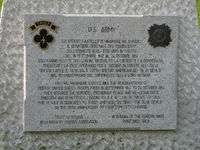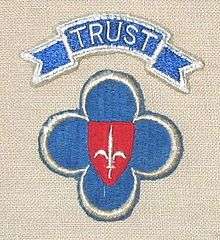88th Infantry Division (United States)
| 88th Division 88th Infantry Division | |
|---|---|
|
88th Infantry Division shoulder sleeve insignia | |
| Active |
1917–1919 1942–1947 |
| Country |
|
| Branch |
|
| Type | Infantry |
| Size | Division |
| Nickname(s) |
"Fighting Blue Devils" "Clover Leaf Division" |
| Engagements | |
The 88th Infantry Division was an infantry division of the United States Army that saw service in both World War I and World War II. It was the first Army of the United States division to be created "from scratch" after the implementation of the draft in 1940. Previous divisions were either Regular Army, Reserve or National Guard. Much of the experience in creating it was used in the subsequent expansion of the U.S. Army.
By the end of World War II the 88th Infantry fought its way to the northernmost extreme of Italy. In early May 1945 troops of its 349th Infantry Regiment joined the 103d Infantry Division of the VI Corps of the U.S. Seventh Army, part of the 6th Army Group, which had raced south through Bavaria into Innsbruck, Austria, in Vipiteno in the Italian Alps.[1]
World War I
- Activated: 5 August 1917, Camp Dodge, Iowa
- Overseas: 7 September 1918
- Major operations: Did not participate as a division
- Casualties: Total-78 (KIA-12; WIA-66)
- Commanders:
- Maj. Gen. Edward H. Plummer (25 August 1917)
- Brig. Gen. Robert N. Getty (27 November 1917)
- Maj. Gen. Edward H. Plummer (19 February 1918)
- Brig. Gen. Robert N. Getty (15 March 1918)
- Brig. Gen. William D. Beach (24 May 1918)
- Maj. Gen. William Weigel (10 September 1918)
- Inactivated: 10 June 1919, Camp Dodge, Iowa
World War II
- Called to active service: 15 July 1942, Camp Gruber, Oklahoma
- Overseas: 6 December 1943
- Distinguished Unit Citations: 3
- Campaigns: Rome-Arno, North Apennines, Po Valley
- Days of combat: 344
- Awards: Medal of Honor-3 ; Distinguished Service Cross (United States)-40 ; Distinguished Service Medal (United States)-2 ; Silver Star-522; Legion of Merit-66; Soldier's Medal-19 ; Bronze Star Medal-3,784.
- Unit citations: Third Battalion, 351st Infantry Regiment (action vicinity Laiatico; 9–13 July 1944). Second Battalion, 350th Infantry Regiment (action on Mt. Battaglia, 27 Sept – 3 Oct 1944). Second Battalion, 351st Infantry Regiment (action vicinity Mt. Cappello, 27 Sept – 1 Oct 1944).
- Commanders:
- Maj. Gen. John E. Sloan (July 1942 – September 1944)
- Maj. Gen. Paul W. Kendall (September 1944 – July 1945)
- Brig. Gen. James C. Fry (July–November 1945)
- Maj. Gen. Bryant Moore (November 1945 to inactivation)
- Inactivated: 24 October 1947 in Italy
Combat chronicle
- First Entered combat: Advance party on night of 3–4 January 1944 in support of Monte Cassino attacks.[2]
- First Organization Committed to Line: 2nd Battalion, 351st Infantry Regiment plus attachments[3]
- First combat fatality: 3 January 1944
- Began post war POW Command: 7 June 1945. Responsible for guarding and later repatriating 324,462 German POWs.[4]
The 88th Infantry Division was one of the first all draftee divisions to enter the war. Formed at Camp Gruber, Oklahoma, the division arrived at Casablanca, French Morocco, 15 December 1943, and moved to Magenta, Algeria, on the 28th for intensive training. Destined to spend the war fighting on the Italian Front, the 88th Division arrived at Naples, Italy, 6 February 1944, and concentrated around Piedimonte d'Alife for combat training. An advance element went into the line before Cassino, 27 February, and the entire unit relieved British elements along the Garigliano River in the Minturno area, 5 March. A period of defensive patrols and training followed.
On 11 May, the 88th drove north to take Spigno, Mount Civita, Itri, Fondi, and Roccagorga, reached Anzio, 29 May, and pursued the enemy into Rome, being the first unit of the U.S. Fifth Army, of which the 88th formed a part, into the city on 4 June, after a stiff engagement on the outskirts of the city. An element of the 88th is credited with being first to enter the Eternal City. After continuing across the Tiber to Bassanelio the 88th retired for rest and training, 11 June. The Division went into defensive positions near Pomerance, 5 July, and launched an attack toward Volterra on the 8th, taking the town the next day. Laiatico fell on the 11th, Villamagna on the 13th, and the Arno River was crossed on the 20th although the enemy resisted bitterly.
After a period of rest and training, the Division opened its assault on the Gothic Line, 21 September 1944, and advanced rapidly along the Firenzuola-Imola road, taking Mount Battaglia (Casola Valsenio, RA) on the 28th. The enemy counterattacked savagely and heavy fighting continued on the line toward the Po Valley. The strategic positions of Mount Grande and Farnetto were taken, 20 and 22 October. From 26 October 1944 to 12 January 1945, the 88th entered a period of defensive patrolling in the Mount Grande-Mount Cerrere sector and the Mount Fano area. From 24 January to 2 March 1945, the Division defended the Loiano-Livergnano area and after a brief rest returned to the front. The drive to the Po Valley began on 15 April. Monterumici fell on the 17th after an intense barrage and the Po River was crossed, 24 April, as the 88th pursued the enemy toward the Alps. The cities of Verona and Vicenza were captured on the 25th and 28th and the Brenta River was crossed, 30 April. The 88th was driving through the Dolomite Alps toward Innsbruck, Austria where it linked up with the 103rd Infantry Division, when the hostilities ended on 2 May 1945.[1] The 88th Infantry Division was in combat for 344 days.
Casualties
- Total battle casualties: 13,111[5]
- Killed in action: 2,298[6]
- Wounded in action: 9,225[7]
- Missing in action: 941[8]
- Prisoner of war: 647[9]
Units

Units associated, assigned or attached to the division during World War II included:
- 349th Infantry Regiment
- 350th Infantry Regiment
- 351st Infantry Regiment
- 337th Field Artillery Battalion
- 338th Field Artillery Battalion
- 339th Field Artillery Battalion
- 913rd Field Artillery Battalion
- 313rd Combat Engineer Battalion
- 313rd Medical Battalion
- 752nd Tank Battalion (attached)
- 88th Reconnaissance Troop (Mechanized)
- 88th Counter Intelligence Corps Detachment
- 88th Infantry Division Military Police Platoon
- 88th Infantry Division Special Troops
- 88th Quartermaster Company
- 88th Signal Company
- 788th Ordnance Light Maintenance Company
- 442nd Infantry Regiment (Nisei) (attached Aug 1944 - Sep 1944)
Post war
After the war, the 88th Infantry Division absorbed some personnel and units from the 34th Infantry Division and served on occupation duty in Italy guarding the Morgan Line from positions in Italy and Trieste until 15 September 1947 when the Italian peace treaty came into force. The 351st Infantry was relieved from assignment to the division on 1 May 1947 and served as temporary military Government of the Free Territory of Trieste, securing the new independent State[10] between Italy and Yugoslavia on behalf of the United Nations Security Council.[11] Designated TRUST (Trieste United States Troops), the command served as the front line in the Cold War from 1947 to 1954, including confrontations with Yugoslavian forces.
In October 1954 the mission ended upon the signing of the Memorandum of Understanding of London [12] establishing a temporary civil administration in the Anglo-American Zone of the Free Territory of Trieste, entrusted to the responsibility of the Italian Government.[13]
TRUST units, which included a number of 88th divisional support units, all bore a unit patch which was the coat of arms of the Free Territory of Trieste superimposed over the divisional quatrefoil, over which was a blue scroll containing the designation "TRUST" in white.

The division shoulder patch is worn by the United States Army Reserve 88th Regional Readiness Command; however, the division lineage is not perpetuated by the 88th RRC. According to the United States Army Center of Military History, RRCs such as the 88th have the same number as inactivated divisions and are allowed to wear the shoulder patch, but division lineage and honors are not inherited by an RRC, which is not considered as a successor to a division.
General
- Shoulder patch: A blue (for Infantry) quatrefoil, formed by two Arabic numeral "8s". A rocker above it with the nickname "Blue Devils" was often worn.
- During World War II, the Germans thought the 88th was an elite stormtrooper Division. This was most likely due to parallels between the "Blue Devil" nickname and patch rocker and the German SS's use of the Totenkopf death's head insignia.
See also
- 1st Lieutenant James Henry Taylor
References
- 1 2 Fifth Army History • Race to the Alps, Chapter VI : Conclusion "On 3 May the 85th and 88th [Infantry] Divisions sent task forces north over ice and snow 3 feet deep to seal the Austrian frontier and to gain contact with the American Seventh Army, driving southward from Germany. The 339th Infantry [85th Division] reached Austrian soil east of Dobbiaco at 0415, 4 May; the Reconnaissance Troop, 349th Infantry [88th Division], met troops from [103rd Infantry Division] VI Corps of Seventh Army at 1051 at Vipiteno, 9 miles south of Brenner."
- ↑ Delaney, p. 37
- ↑ Delaney, p. 45
- ↑ Delaney, p. 359
- ↑ Army Battle Casualties and Nonbattle Deaths, Final Report (Statistical and Accounting Branch, Office of the Adjutant General, 1 June 1953)
- ↑ Army Battle Casualties and Nonbattle Deaths, Final Report (Statistical and Accounting Branch, Office of the Adjutant General, 1 June 1953)
- ↑ Army Battle Casualties and Nonbattle Deaths, Final Report (Statistical and Accounting Branch, Office of the Adjutant General, 1 June 1953)
- ↑ Army Battle Casualties and Nonbattle Deaths, Final Report (Statistical and Accounting Branch, Office of the Adjutant General, 1 June 1953)
- ↑ Army Battle Casualties and Nonbattle Deaths, Final Report (Statistical and Accounting Branch, Office of the Adjutant General, 1 June 1953)
- ↑ Article 21 and Annex VII, Instrument for the Provisional Regime of the Free Territory of Trieste. See: https://treaties.un.org/doc/Publication/UNTS/Volume%2049/v49.pdf
- ↑ see: United Nations Security Council Resolution 16, 10 January 1947: http://www.un.org/en/ga/search/view_doc.asp?symbol=S/RES/16(1947)
- ↑ UNTS Vol.235, 3297 Memorandum of Understanding of London
- ↑ Memorandum of Understanding of London, article 2: see https://treaties.un.org/doc/Publication/UNTS/Volume%20235/v235.pdf
- Bibliography
- The Army Almanac: A Book of Facts Concerning the Army of the United States U.S. Government Printing Office, 1950 reproduced at http://www.history.army.mil/html/forcestruc/cbtchron/cbtchron.html. (public domain, work of U.S. government)
- About Face: The Odyssey of an American Warrior, by David Hackworth: pp 35, 308.
- Brown, John Sloan. Draftee Division: the 88th Infantry Division in World War II. Lexington, KY: University Press of Kentucky, 1986. ISBN 0813115817
- Delaney, John P. The Blue Devils in Italy: a history of the 88th Infantry Division in World War II. Washington: Infantry Journal Press, [1947] OCLC 2617939 1988 reprint is also available.
External links
- History of the 88th Division in the Great War
- The 88th Division in the World War of 1914 – 1918
- We Were There: From Gruber to the Brenner Pass
- The battle of Cornuda, the 88th division's last battle of World War II
- Oral history interview with Nicholas Cipu, a Staff Sergeant in the 88th Infantry Division, during World War II from the Veterans History Project at Central Connecticut State University
- 752nd Tank Battalion in World War II
